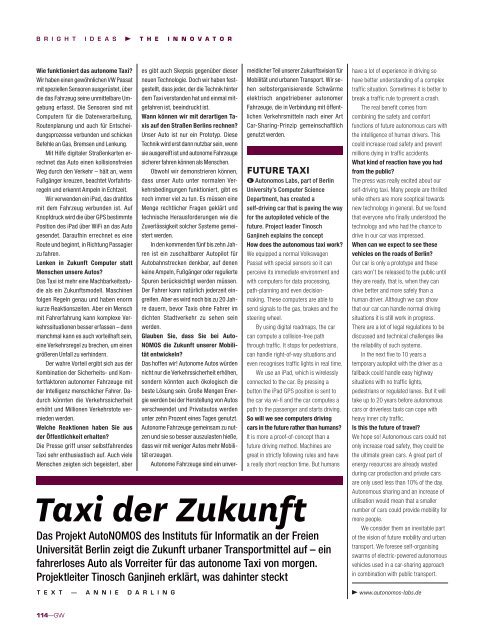october-2011
october-2011
october-2011
Sie wollen auch ein ePaper? Erhöhen Sie die Reichweite Ihrer Titel.
YUMPU macht aus Druck-PDFs automatisch weboptimierte ePaper, die Google liebt.
B R I G H T I D E A S T H E I N N O V A T O R<br />
Wie funktioniert das autonome Taxi?<br />
Wir haben einen gewöhnlichen VW Passat<br />
mit speziellen Sensoren ausgerüstet, über<br />
die das Fahrzeug seine unmittelbare Umgebung<br />
erfasst. Die Sensoren sind mit<br />
Computern für die Datenverarbeitung,<br />
Routenplanung und auch für Entscheidungsprozesse<br />
verbunden und schicken<br />
Befehle an Gas, Bremsen und Lenkung.<br />
Mit Hilfe digitaler Straßenkarten errechnet<br />
das Auto einen kollisionsfreien<br />
Weg durch den Verkehr – hält an, wenn<br />
Fußgänger kreuzen, beachtet Vorfahrtsregeln<br />
und erkennt Ampeln in Echtzeit.<br />
Wir verwenden ein iPad, das drahtlos<br />
mit dem Fahrzeug verbunden ist. Auf<br />
Knopfdruck wird die über GPS bestimmte<br />
Position des iPad über WiFi an das Auto<br />
gesendet. Daraufhin errechnet es eine<br />
Route und beginnt, in Richtung Passagier<br />
zu fahren.<br />
Lenken in Zukunft Computer statt<br />
Menschen unsere Autos?<br />
Das Taxi ist mehr eine Machbarkeitsstudie<br />
als ein Zukunftsmodell. Maschinen<br />
folgen Regeln genau und haben enorm<br />
kurze Reaktionszeiten. Aber ein Mensch<br />
mit Fahrerfahrung kann komplexe Verkehrssituationen<br />
besser erfassen – denn<br />
manchmal kann es auch vorteilhaft sein,<br />
eine Verkehrsregel zu brechen, um einen<br />
größeren Unfall zu verhindern.<br />
Der wahre Vorteil ergibt sich aus der<br />
Kombination der Sicherheits- und Komfortfaktoren<br />
autonomer Fahrzeuge mit<br />
der Intelligenz menschlicher Fahrer. Dadurch<br />
könnten die Verkehrssicherheit<br />
erhöht und Millionen Verkehrstote vermieden<br />
werden.<br />
Welche Reaktionen haben Sie aus<br />
der Öffentlichkeit erhalten?<br />
Die Presse griff unser selbstfahrendes<br />
Taxi sehr enthusiastisch auf. Auch viele<br />
Menschen zeigten sich begeistert, aber<br />
es gibt auch Skepsis gegenüber dieser<br />
neuen Technologie. Doch wir haben festgestellt,<br />
dass jeder, der die Technik hinter<br />
dem Taxi verstanden hat und einmal mitgefahren<br />
ist, beeindruckt ist.<br />
Wann können wir mit derartigen Taxis<br />
auf den Straßen Berlins rechnen?<br />
Unser Auto ist nur ein Prototyp. Diese<br />
Technik wird erst dann nutzbar sein, wenn<br />
sie ausgereift ist und autonome Fahrzeuge<br />
sicherer fahren können als Menschen.<br />
Obwohl wir demonstrieren können,<br />
dass unser Auto unter normalen Verkehrsbedingungen<br />
funktioniert, gibt es<br />
noch immer viel zu tun. Es müssen eine<br />
Menge rechtlicher Fragen geklärt und<br />
technische Herausforderungen wie die<br />
Zuverlässigkeit solcher Systeme gemeistert<br />
werden.<br />
In den kommenden fünf bis zehn Jahren<br />
ist ein zuschaltbarer Autopilot für<br />
Autobahnstrecken denkbar, auf denen<br />
keine Ampeln, Fußgänger oder regulierte<br />
Spuren berücksichtigt werden müssen.<br />
Der Fahrer kann natürlich jederzeit eingreifen.<br />
Aber es wird noch bis zu 20 Jahre<br />
dauern, bevor Taxis ohne Fahrer im<br />
dichten Stadtverkehr zu sehen sein<br />
werden.<br />
Glauben Sie, dass Sie bei Auto-<br />
NOMOS die Zukunft unserer Mobilität<br />
entwickeln?<br />
Das hoffen wir! Autonome Autos würden<br />
nicht nur die Verkehrssicherheit erhöhen,<br />
sondern könnten auch ökologisch die<br />
beste Lösung sein. Große Mengen Energie<br />
werden bei der Herstellung von Autos<br />
verschwendet und Privatautos werden<br />
unter zehn Prozent eines Tages genutzt.<br />
Autonome Fahrzeuge gemeinsam zu nutzen<br />
und sie so besser auszulasten hieße,<br />
dass wir mit weniger Autos mehr Mobilität<br />
erzeugen.<br />
Autonome Fahrzeuge sind ein unver-<br />
meidlicher Teil unserer Zukunftsvision für<br />
Mobilität und urbanen Transport. Wir sehen<br />
selbstorganisierende Schwärme<br />
elektrisch angetriebener autonomer<br />
Fahrzeuge, die in Verbindung mit öffentlichen<br />
Verkehrsmitteln nach einer Art<br />
Car-Sharing-Prinzip gemeinschaftlich<br />
genutzt werden.<br />
FUTURE TAXI<br />
Autonomos Labs, part of Berlin<br />
University’s Computer Science<br />
Department, has created a<br />
self-driving car that is paving the way<br />
for the autopiloted vehicle of the<br />
future. Project leader Tinosch<br />
Ganjineh explains the concept<br />
How does the autonomous taxi work?<br />
We equipped a normal Volkswagen<br />
Passat with special sensors so it can<br />
perceive its immediate environment and<br />
with computers for data processing,<br />
path-planning and even decisionmaking.<br />
These computers are able to<br />
send signals to the gas, brakes and the<br />
steering wheel.<br />
By using digital roadmaps, the car<br />
can compute a collision-free path<br />
through traffi c. It stops for pedestrians,<br />
can handle right-of-way situations and<br />
even recognises traffi c lights in real time.<br />
We use an iPad, which is wirelessly<br />
connected to the car. By pressing a<br />
button the iPad GPS position is sent to<br />
the car via wi-fi and the car computes a<br />
path to the passenger and starts driving.<br />
So will we see computers driving<br />
cars in the future rather than humans?<br />
It is more a proof-of-concept than a<br />
future driving method. Machines are<br />
great in strictly following rules and have<br />
a really short reaction time. But humans<br />
Taxi der Zukunft<br />
Das Projekt AutoNOMOS des Instituts für Informatik an der Freien<br />
Universität Berlin zeigt die Zukunft urbaner Transportmittel auf – ein<br />
fahrerloses Auto als Vorreiter für das autonome Taxi von morgen.<br />
Projektleiter Tinosch Ganjineh erklärt, was dahinter steckt<br />
T E X T — A N N I E D A R L I N G<br />
114—GW<br />
have a lot of experience in driving so<br />
have better understanding of a complex<br />
traffi c situation. Sometimes it is better to<br />
break a traffi c rule to prevent a crash.<br />
The real benefi t comes from<br />
combining the safety and comfort<br />
functions of future autonomous cars with<br />
the intelligence of human drivers. This<br />
could increase road safety and prevent<br />
millions dying in traffi c accidents.<br />
What kind of reaction have you had<br />
from the public?<br />
The press was really excited about our<br />
self-driving taxi. Many people are thrilled<br />
while others are more sceptical towards<br />
new technology in general. But we found<br />
that everyone who fi nally understood the<br />
technology and who had the chance to<br />
drive in our car was impressed.<br />
When can we expect to see these<br />
vehicles on the roads of Berlin?<br />
Our car is only a prototype and these<br />
cars won’t be released to the public until<br />
they are ready, that is, when they can<br />
drive better and more safely than a<br />
human driver. Although we can show<br />
that our car can handle normal driving<br />
situations it is still work in progress.<br />
There are a lot of legal regulations to be<br />
discussed and technical challenges like<br />
the reliability of such systems.<br />
In the next fi ve to 10 years a<br />
temporary autopilot with the driver as a<br />
fallback could handle easy highway<br />
situations with no traffi c lights,<br />
pedestrians or regulated lanes. But it will<br />
take up to 20 years before autonomous<br />
cars or driverless taxis can cope with<br />
heavy inner city traffi c.<br />
Is this the future of travel?<br />
We hope so! Autonomous cars could not<br />
only increase road safety, they could be<br />
the ultimate green cars. A great part of<br />
energy resources are already wasted<br />
during car production and private cars<br />
are only used less than 10% of the day.<br />
Autonomous sharing and an increase of<br />
utilisation would mean that a smaller<br />
number of cars could provide mobility for<br />
more people.<br />
We consider them an inevitable part<br />
of the vision of future mobility and urban<br />
transport. We foresee self-organising<br />
swarms of electric-powered autonomous<br />
vehicles used in a car-sharing approach<br />
in combination with public transport.<br />
www.autonomos-labs.de














